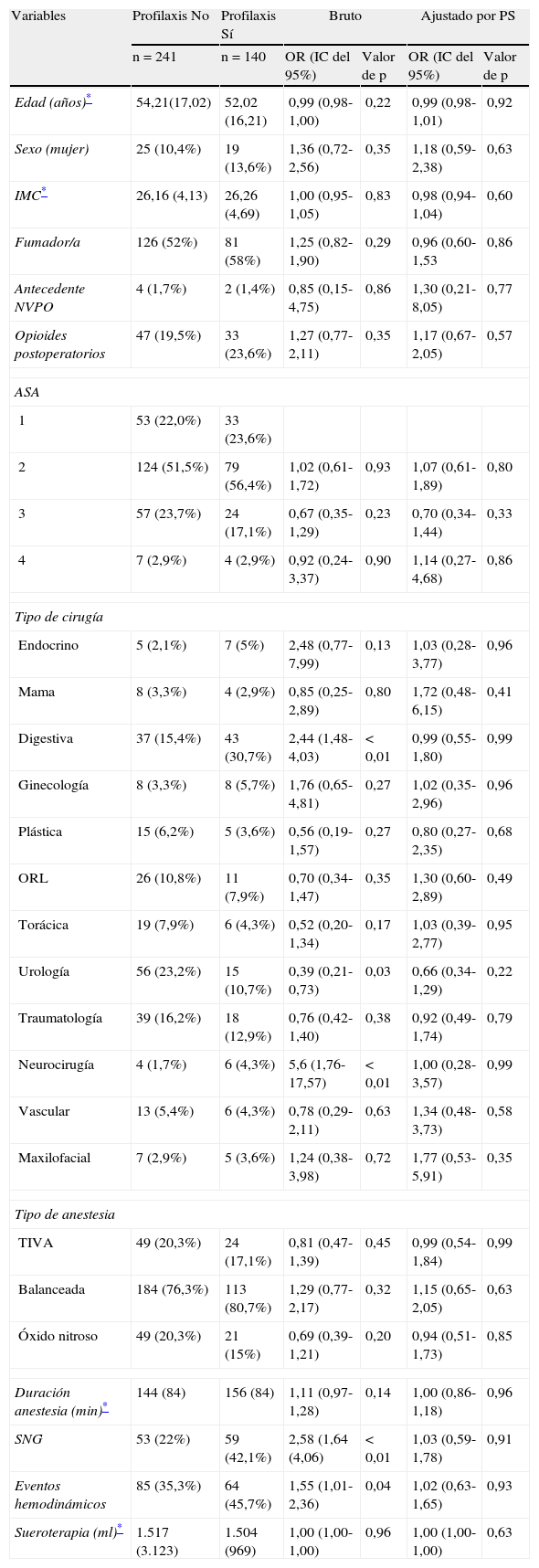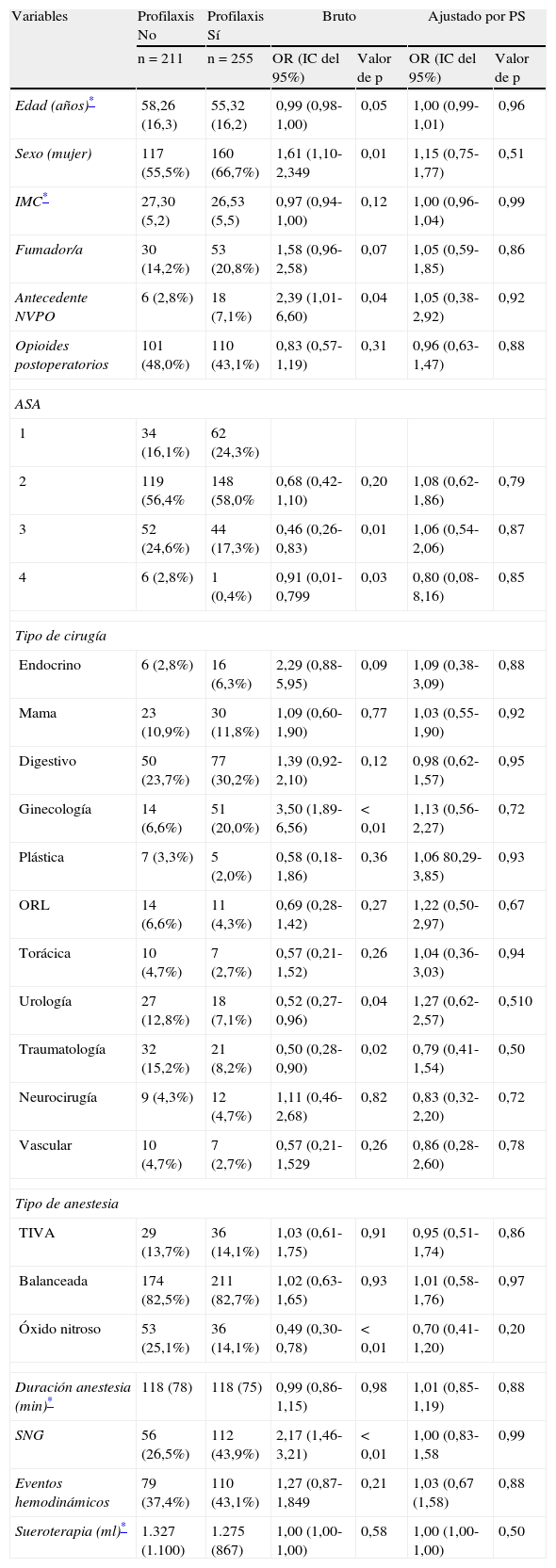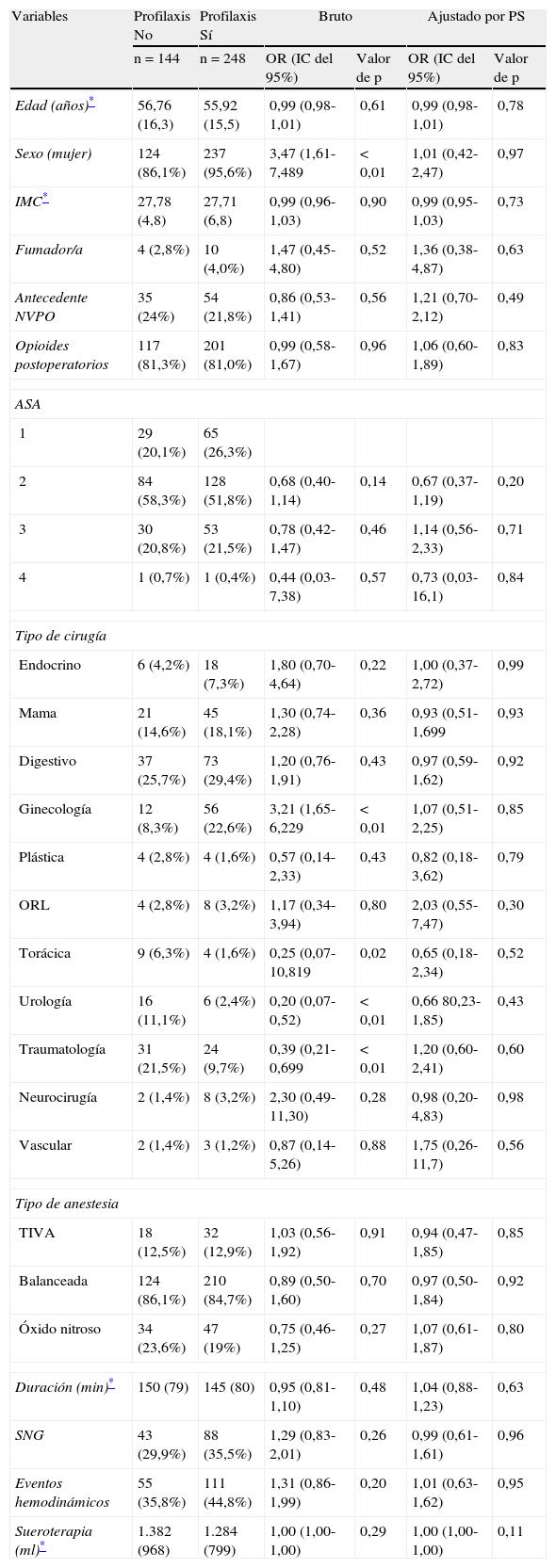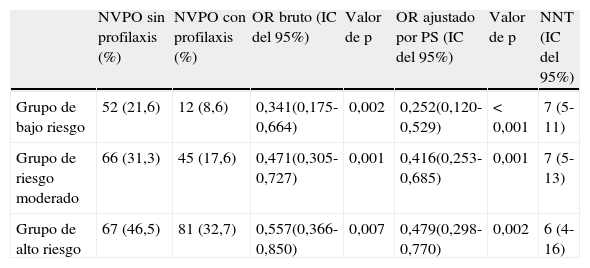Valorar la eficiencia de la profilaxis antiemética farmacológica en pacientes sometidos a una intervención quirúrgica, bajo anestesia general, en diferentes grupos de riesgo de náuseas y vomitos postoperatorios (NVPO).
Material y métodosSe diseñó un estudio multicéntrico aleatorio prospectivo observacional de cohortes. Se estudiaron 1.239 pacientes procedentes de 26 hospitales sometidos a cirugía programada con anestesia general. Fueron registradas las características poblacionales, los factores de riesgo de NVPO, la técnica anestésica, el tipo de cirugía, la duración, la fluidoterapia, la profilaxis antiemética administrada y la incidencia de NVPO en las primeras 24h. Se realizó un análisis estratificado (riesgo bajo, moderado y alto) encaminado a evaluar la asociación entre profilaxis y NVPO mediante un modelo de regresión logística ajustado por propensity score. Posteriormente, se calculó en cada uno de los estratos el número de pacientes que es necesario tratar (NNT), para evitar un episodio de NVPO.
ResultadosLa incidencia de NVPO en el estrato de bajo riesgo fue del 21,6% sin profilaxis y del 8,6% con profilaxis, en el de riesgo moderado fue del 31,3% frente al 17,7% y en el de alto riesgo del 46,5% frente al 32,7%. Hubo un efecto protector de la profilaxis de forma significativa en los 3 estratos (odds ratio entre pacientes tratados y no tratados) y el NNT (IC del 95%) fue de 7 (5-11) en el estrato de bajo riesgo, 7 (5-13) en el de riesgo moderado y 6 (4-16) en el de riesgo elevado.
ConclusionesLa eficiencia de la profilaxis antiemética farmacológica en pacientes sometidos a cirugía con anestesia general fue similar en todos los grupos de riesgo. La privación de profilaxis antiemética en los pacientes de bajo riesgo puede no estar justificada por criterios de coste-efectividad. Las futuras guías clínicas para la mejora de la calidad asistencial, de los pacientes intervenidos con anestesia general deberán considerar la conveniencia de una profilaxis universal de las NVPO.
To assess the efficiency of pharmacological antiemetic prophylaxis in patients subjected to surgery under general anaesthetic in different postoperative nausea and vomiting (NVPO) risk groups.
Material and methodsA randomised, observational, prospective and multicentre cohort study was conducted. The study included 1239 patients from 26 hospitals who were subjected to elective surgery under general anaesthesia. The data collected included, demographic characteristics, the NVPO risk factors, anaesthetic technique, type of surgery, the duration, fluid therapy, antiemetic prophylaxis administered, and the incidence of NVPO in the first 24h after surgery. A stratified analysis (low, moderate and high risk) was performed with the intention of evaluating the relationship between prophylaxis and NVPO using a logistic regression model adjusted for propensity score. The number of patients needed to treat (NNT) to prevent an NVPO episode was then calculated for each of the strata.
ResultsThe incidence of NVPO in the low risk stratum was 21.6% without prophylaxis and 8.6% with prophylaxis, 31.3% compared to 17.7% in the moderate risk, and 46.5% compared to 32.7% in the high risk group. There was a significant protective effect in the three strata (odds ratio between treated and untreated patients) and in the NNT (95% CI) was 7 (5-11) in the low risk stratum, 7 (5-13) in that of the moderate risk, and 6 (4-16) in the high risk.
ConclusionsThe efficiency of pharmacological antiemetic prophylaxis in patients subjected to surgery under general anaesthesia was similar in all risk groups. Not providing antiemetic prophylaxis in low risk patients may not be justified due to the cost-effectiveness criteria. Future clinical guidelines to improve the quality of health care of patients operated on under general anaesthesia should consider the advantages of a universal NVPO prophylaxis.
Artículo
Comprando el artículo el PDF del mismo podrá ser descargado
Precio 19,34 €
Comprar ahora












